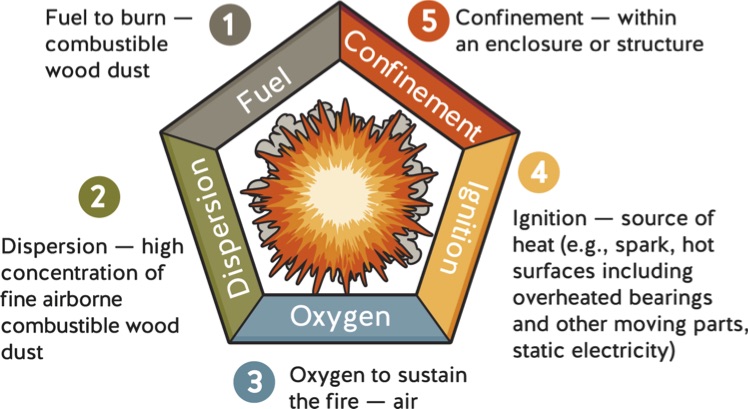
Features
Health and Safety
Sawmilling
Risk assessment: The first step to controlling combustible dust hazards
June 23, 2020 By WorkSafeBC
 If a high concentration of wood dust becomes airborne and contacts an ignition source in a contained area, an explosion will likely occur.
If a high concentration of wood dust becomes airborne and contacts an ignition source in a contained area, an explosion will likely occur. Combustible dust fire and explosion risks grow silently – on places like ceiling beams and trusses and other out-of-sight areas. Tragically, we know too well that if it’s not managed properly, combustible dust can catch fire and burn or cause an explosion, potentially resulting in injuries to workers. But how much do we know about these hazards in our own sawmills and pellet plants?
Do you know what kind of dust is in your workplace? Where does it accumulate? What ignition sources are present? Finding accurate answers to these questions – and many more – is a lot more complex than it may seem on the surface, but is critical for keeping your workers and business safe. Conducting a risk assessment to identify the potential hazards of combustible wood dust in your workplace is the first step.
It takes some legwork at first, but in the end, your efforts will result in being in compliance with workplace health and safety regulations. In B.C., in addition to the Occupational Health and Safety Regulation, you also need to comply with the safety requirements in the BC Fire Code, the Safety Standards Act (electrical and gas installations), and the BC Building Code.
Finding the right professional
To help you conduct a thorough risk assessment and understand the requirements for reducing your risk of combustible dust explosions, seek help from your industry health and safety association or industry representatives, research online for options, or contact your colleagues and peers network. Finding someone qualified in assessing combustible dust fire and explosion risks in processes, equipment, and buildings will ensure they can accurately evaluate your current handling practices, equipment, fire extinguishing systems, and other dust mitigation efforts.
It’s important to keep in mind that there are no specific degrees or certificates that demonstrate a person has the necessary skills and knowledge to perform a combustible dust risk assessment. You’ll want to find out more about their skills and expertise before you hire them to review your business practices. Here are a few things to consider:
- Ask for documentation, such as a resume or CV, that includes the individual’s job title or expertise, responsibilities, and employment history.
- Ask for proof of their expertise, such as copies of degrees, certificates, licenses, published articles, or previous reports.
- Contact three references, with at least one who has experience in an industry similar to yours.
Finding new, improved solutions
An explosion happens when dust is disturbed and released into the air in a contained area where there is an ignition source, such as a welding spark or static electricity. A risk assessment will identify any potential risks of a combustible dust explosion in your facility.
The first step is a comprehensive on-site risk assessment. The goal of the assessment is to identify hazards and the levels of risk they pose to your workers. Documenting all of this will be the basis of the risk assessment report. You will want a report that is readable and well-presented so that you are able to use it as your primary tool for controlling combustible dust hazards.
The Dust Explosion Pentagon (below) shows you how an explosion results from five contributing factors when they exist simultaneously.

If a high concentration of wood dust becomes airborne and contacts an ignition source in a contained area, an explosion will likely occur.
During a risk assessment, you will need to analyze:
- All buildings and structures on your site
- Concealed spaces such as attics, false ceilings, crawl spaces, etc.
- Elevated horizontal surfaces
- Basement areas
- Fully or partially contained, enclosed, or compartmentalized areas
- Mechanical and electrical equipment and their enclosures
- Outside areas adjacent to buildings and structures
- Processes that use, consume, produce, or handle combustible dusts
- Work activities that may introduce potential ignition sources
You will also need to consider potential ignition sources, including but not limited to:
- Hot work (like welding or torch-cutting metal)
- Hot surfaces
- Open flame or fuel-fired heating equipment
- Friction points (including bearings, drives, and gear reducers)
- Machine and processing equipment
- Electrical systems (including facility lighting)
- Static electricity
- Smoking
- Lightning
- Tramp metal/foreign material
Reviewing and revising your risk assessment findings
A risk assessment report doesn’t need to be fancy; it just needs to outline the basic hazards and the levels of risk these hazards pose to workers. You will use it as a basis for your company’s annual safety plan – to help you set priorities and goals for minimizing risk, while using available resources as efficiently as possible.
You will need to review and update your risk assessment whenever you introduce new equipment, materials, or work processes. At a minimum, updating it annually will ensure sure it’s accurate for the needs of your workers.
For more information on the hazards of combustible dust in your workplace, register for the “Demystifying the Dust Hazard Analysis” webinar on Thursday, June 25 at 1:00 p.m. EST. This free, one-hour event is available online as part of the fourth-annual Canada-wide Dust Safety Week June 22 to 26.
To learn how you can ensure the health and safety of your workers, and reduce your risk of combustible dust explosions, find resources at worksafebc.com/combustible-dust.
This article is part of our 2020 Dust Safety Week coverage. Find more articles here.
Print this page